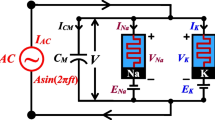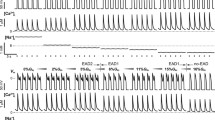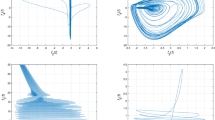Abstract
Sudden cardiac arrest is a widespread cause of death in the industrialized world. Most cases of sudden cardiac arrest are due to ventricular fibrillation (VF), a lethal cardiac arrhythmia. Electrophysiological abnormalities such as alternans (a beat-to-beat alternation in action potential duration) and conduction block have been suspected to contribute to the onset of VF. This study focuses on the use of control-systems techniques to analyze and design methods for suppressing these precursor factors. Control-systems tools, specifically controllability analysis and Lyapunov stability methods, were applied to a two-variable Karma model of the action-potential (AP) dynamics of a single cell, to analyze the effectiveness of strategies for suppressing AP abnormalities. State-feedback-integral (SFI) control was then applied to a Purkinje fiber simulated with the Karma model, where only one stimulating electrode was used to affect the system. SFI control converted both discordant alternans and 2:1 conduction block back toward more normal patterns, over a wider range of fiber lengths and pacing intervals compared with a Pyragas-type chaos controller. The advantages conferred by using feedback from multiple locations in the fiber, and using integral (i.e., memory) terms in the controller, are discussed.




Similar content being viewed by others
References
American Heart Association. 2005 American Heart Association guidelines for cardiopulmonary resuscitation and emergency cardiovascular care, Part 3: overview of CPR. Circulation 112:IV-12–IV-18, 2005.
Berger, C. M., J. W. Cain, J. E. S. Socolar, and D. J. Gauthier. Control of electrical alternans in simulations of paced myocardium using extended time-delay autosynchronization. Phys. Rev. E 76:041917-1–041917-10, 2007.
Christini, D. J., M. L. Riccio, C. A. Culianu, J. J. Fox, A. Karma, and R. F. Gilmour, Jr. Control of electrical alternans in canine cardiac Purkinje fibers. Phys. Rev. Lett. 96:104101-1–104101-4, 2006.
Christini, D. J., K. M. Stein, S. M. Markowitz, S. Mittal, D. J. Slotwiner, M. A. Scheiner, S. Iwai, and B. B. Lerman. Nonlinear-dynamical arrhythmia control in humans. Proc. Natl Acad. Sci. 98(10):5827–5832, 2001.
Dubljevic, S. Optimal boundary control of cardiac alternans. Int. J. Robust Nonlinear Control 19:135–150, 2009.
Dubljevic, S., S.-F. Lin, and P. D. Christofides. Studies on feedback control of cardiac alternans. Comput. Chem. Eng. 32:2086–2098, 2008.
Echebarria, B., and A. Karma. Spatiotemporal control of cardiac alternans. Chaos 12(3):923–930, 2002.
Fox, J. J., M. L. Riccio, F. Hua, E. Bodenschatz, and R. F. Gilmour, Jr. Spatiotemporal transition to conduction block in canine ventricle. Circ. Res. 90(3):289–296, 2002.
Garzón, A., R. O. Grigoriev, and F. H. Fenton. Model-based control of cardiac alternans on a ring. Phys. Rev. E 80:021932-1–021932-12, 2009.
Gray, R. A. Termination of spiral wave breakup in a Fitzhugh-Nagumo model via short and long duration stimuli. Chaos 12(3):941–951, 2002.
Hall, K., D. J. Christini, M. Tremblay, J. J. Collins, L. Glass, and J. Billette. Dynamic control of cardiac alternans. Phys. Rev. Lett. 78(23):4518–4521, 1992.
Hall, G. M., and D. J. Gauthier. Experimental control of cardiac muscle alternans. Phys. Rev. Lett. 88(19):198102-1–198102-4, 2002.
Karma, A. Spiral breakup in model equations of action potential propagation in cardiac tissue. Phys. Rev. Lett. 71(7):1103–1106, 1993.
Karma, A. Electrical alternans and spiral wave breakup in cardiac tissue. Chaos 4(3):461–472, 1994.
Khalil, H. K. Nonlinear Systems, 2nd ed. New Jersey: Prentice Hall, 1996.
Lou, K.-J., and S. Dubljevic. Mechano-electric suppression of cardiac alternans. Proceedings of the American Control Conference, pp. 2564–2570, 2008.
Osipov, G. V., and J. J. Collins. Using weak impulses to suppress traveling waves in excitable media. Phys. Rev. E 60(1):54–57, 1999.
Otani, N. F., D. Allexandre, and M. Li. Advanced methods for assessing the stability and control of alternans. In: Cardiac Bioelectric Therapy: Mechanisms and Practical Implications, Chapter 6.4, edited by I. R. Efimov, M. W. Kroll, and P. J. Tchou. Springer, 2008.
Rappel, W.-J., F. Fenton, and A. Karma. Spatiotemporal control of wave instabilities in cardiac tissue. Phys. Rev. Lett. 83(2):456–459, 1999.
Sinha, S., J. Henrichs, and B. Ravindra. A general approach in the design of active controllers for nonlinear systems exhibiting chaos. Int. J. Bifurcat. Chaos 10(1):165–178, 2000.
Yaniv, Y., R. Sivan, and A. Landesberg. Stability, controllability, and observability of the “four state” model for the sarcomeric control of contraction. Ann. Biomed. Eng. 34(5):778–789, 2006.
Zheng, Z.-J., J. B. Croft, W. H. Giles, and G. A. Mensah. Sudden cardiac death in the United States, 1989 to 1998. Circulation 104:2158–2163, 2001.
Zipes, D. P. and H. J. J. Wellens. Sudden cardiac death. Circulation 98:2334–2351, 1998.
Acknowledgments
The authors would like to thank Professor Robert Gilmour, Jr., Dr. Flavio Fenton, Dr. Elizabeth Cherry, Professor David Christini, and the anonymous reviewers, for their insights and suggestions in improving this study. The project described was supported in part by Award Number R01HL089271 from the National Heart, Lung, And Blood Institute. The content is solely the responsibility of the authors and does not necessarily represent the official views of the National Heart, Lung, And Blood Institute or the National Institutes of Health.
Author information
Authors and Affiliations
Corresponding author
Additional information
Associate Editor Leonidas D. Iasemidis oversaw the review of this article.
Electronic supplementary material
Below is the link to the electronic supplementary material.
Appendix
Appendix
Lyapunov analysis was used to assess the stability of Eq. (3), which is non-autonomous. A number of restrictions were imposed: θ(·) was replaced by θc(V − V n ) = 0.5(1 + tanh(c a(V − V n ))) in Eqs. (1)–(3), and it was assumed that i d(t) is a continuous function of time, and that \(\tilde{i}(t) = -K\tilde{V}(t).\) The single-cell case of the dynamic equations was used. Under all these assumptions, the right-hand sides of Eqs. (1) and (2) satisfy sufficient conditions for existence and uniqueness of solutions, local to a given initial time and set of initial conditions. However, a stronger assumption was made, that the desired trajectories, V d(t), and n d(t), are bounded (not necessarily periodic) for all times t ≥ t 0. A shorthand version of the continuous-time error dynamics (Eq. 3), for the closed-loop single-cell case, was written as \(\dot{{{\mathbf{s}}}} = \phi({{\mathbf{s}}},t).\) Here, the system state consists of the errors for the membrane potential and gating variable of the single cell, i.e., \({{\mathbf{s}}} = [\tilde{V}\; \tilde{n}]^{\text{T}}.\) The point \((\tilde{V}=0, \tilde{n}=0)\) is an equilibrium point of the system.
The following theorems are equivalent to statements found in Khalil.15 Specifically, Theorem 1 corresponds to Corollary 3.4 of Theorem 3.8, and Theorem 2 corresponds to Theorem 3.11.
Theorem 1
Lets = 0 be an equilibrium point for\(\dot{{{\mathbf{s}}}} = \phi_1({{\mathbf{s}}},t),\)where ϕ1is piecewise continuous in t and locally Lipschitz in a domain D that containss = 0. LetW(s) be a continuously differentiable function such that W is PD and\(\dot{W}({{\mathbf{s}}})\)is ND for alls ∈ D. Furthermore, suppose that\(W({{\mathbf{s}}})=k_1\|{{\mathbf{s}}}\|^q\)and\(\dot{W}({{\mathbf{s}}}) \leq -k_2\|{{\mathbf{s}}}\|^q,\)for some positive constantsk1, k2, and q. Thens = 0 is exponentially stable.
Theorem 2
Lets = 0 be an equilibrium point for the system\(\dot{{{\mathbf{s}}}} = \phi({{\mathbf{s}}},t),\)where\(\phi\hbox{: }[t_0,\infty)\times D \rightarrow {\mathbb{R}}^N\)is continuously differentiable, \(D=\{{{\mathbf{s}}}\in{\mathbb{R}}^N | \|{{\mathbf{s}}}\|_2 < r\}, \, r>0,\)and the Jacobian\(\frac{\partial \phi}{\partial {{\mathbf{s}}}}\)is bounded and Lipschitz on D, uniformly in t. Define\(A(t)=\frac{\partial \phi}{\partial{{\mathbf{s}}}}({{\mathbf{s}}},t)|_{{{\mathbf{s}}}=0}.\)Then, s = 0 is an exponentially stable equilibrium point for the non-linear system if it is an exponentially stable equilibrium point for\(\dot{{{\mathbf{s}}}}=A(t){{\mathbf{s}}}.\)
The version of Theorem 1 in Khalil15 is more general in that it covers cases where W either has explicit time dependence or takes forms other than \(k_1\|{{\mathbf{s}}}\|^q.\) In Theorem 2, note that the region over which stability holds may be smaller than r. See Khalil15 for proofs of the theorems.
Let D be a ball of finite radius that includes the origin. To apply the first theorem, let ϕ1(s, t) = A(t)s, where A(t) is the Jacobian of ϕ(s, t) (where ϕ is the right-hand side of the closed-loop single-cell error dynamics), evaluated at s = 0. Specifically,
where
ϕ1(s, t) is at least piecewise continuous in t (in fact, it is fully continuous in t), since the elements of A(t) are continuous functions of the continuous functions V d(t) and n d(t). Additionally, ϕ1(s, t) is Lipschitz in D because all the elements of A(t) are bounded for all t ≥ t 0. Each matrix element is bounded for bounded values of V d and n d, which are bounded by assumption.
Consider the function
W as defined in Eq. (8) is continuously differentiable and PD by inspection. Applying the chain rule and substituting in the linearized two-variable Karma equations for a single-cell,
is obtained. To satisfy the remainder of Theorem 1, it would be sufficient to find k 2 > 0 for which
Moving all terms to the left side of the inequality, and completing the square (which involves adding a net zero quantity to both sides) yields
where \(\bar{\alpha}_{11}=\alpha_{11} + k_2\) and \(\bar{\alpha}_{22}=\alpha_{22} + k_2.\) Suppose that \(0<k_2<\frac{1}{\tau_n}\) (τ n = 250 in the default units). Then, \(\bar{\alpha}_{22}=-\frac{1}{\tau_n}+ k_2 <0,\) which renders the second term, \(\bar{\alpha}_{22}\left(\frac{(\alpha_{12} + \alpha_{21})}{2\bar{\alpha}_{22}}\tilde{V} + \tilde{n}\right)^{2},\) on the left side of the inequality nonpositive; hence,
The quantity on the right side of the inequality is non-positive as long as
for all t ≥ t 0. The expression on the right side of the inequality is bounded, since the elements of A(t) are bounded, and \(\bar{\alpha}_{22}\neq 0.\) For values of K sufficiently far to the left (possibly negative) on the real axis, the conditions of Theorem 1 are satisfied for \(k_1=\frac{1}{2},\quad 0<k_2<\frac{1}{\tau_n},\) and q = 2. Thus, the origin is exponentially stable for \(\dot{{{\mathbf{s}}}} = \phi_1({{\mathbf{s}}},t) = A(t){{\mathbf{s}}}.\)
The first condition of Theorem 2 concerns the non-linear system \(\dot{{{\mathbf{s}}}} = \phi({{\mathbf{s}}},t).\) Note that ϕ t (s, t) exists and is continuous, since \(\dot{V}^d\) and \(\dot{n}^d\) are continuous by assumption. Writing out the Jacobian matrix, \(J({{\mathbf{s}}},t)=\frac{\partial \phi}{\partial {{\mathbf{s}}}},\) reveals that its elements are continuous functions of \(V^d-\tilde{V}\) and \(n^d-\tilde{n}.\) Hence, ϕ(s, t) is continuously differentiable. The Jacobian is bounded for all t ≥ t 0, since its elements are functions that are bounded for all bounded values of \(V^d-\tilde{V}\) and \(n^d-\tilde{n}.\) V d and n d are bounded, for all time, by assumption, and \(\tilde{V}\) and \(\tilde{n}\) are bounded because s ∈ D. For the product of the Jacobian and the state, ζ(s, t) = J(s, t)s, to be Lipschitz in D, with the same Lipschitz bound for all t ≥ t 0, it is sufficient to establish that (1) ζ is continuous in its arguments, (2) \(\frac{\partial \zeta}{\partial {{\mathbf{s}}}}\) exists and is continuous, and (3) \(\frac{\partial \zeta}{\partial {{\mathbf{s}}}}\) is bounded, for all t ≥ t 0 and points in D. ζ(s, t) is continuous since J(s, t) is continuous in its arguments. Assuming M ≥ 2, and noting that the elements of the Jacobian are continuously differentiable functions of \(V^d-\tilde{V}\) and \(n^d-\tilde{n},\) the elements of \(\frac{\partial \zeta}{\partial {{\mathbf{s}}}}\) exist and are continuous functions of s and t, defined for all bounded values of s and all t ≥ t 0. Finally, \(\frac{\partial \zeta}{\partial {{\mathbf{s}}}}\) is bounded for all t ≥ t 0, since its elements are functions that are bounded for all bounded values of \(V^d-\tilde{V}\) and \(n^d-\tilde{n}.\) Therefore, the conditions of Theorem 2 are satisfied, which means that s = 0 is an exponentially stable equilibrium point for the non-linear system \(\dot{{{\mathbf{s}}}} = \phi({{\mathbf{s}}},t),\) because it is an exponentially stable equilibrium point for \(\dot{{{\mathbf{s}}}}=A(t){{\mathbf{s}}}.\)
Rights and permissions
About this article
Cite this article
Muñoz, L.M., Stockton, J.F. & Otani, N.F. Applications of Control Theory to the Dynamics and Propagation of Cardiac Action Potentials. Ann Biomed Eng 38, 2865–2876 (2010). https://doi.org/10.1007/s10439-010-0037-z
Received:
Accepted:
Published:
Issue Date:
DOI: https://doi.org/10.1007/s10439-010-0037-z




